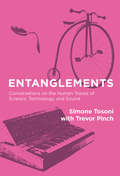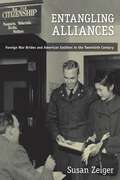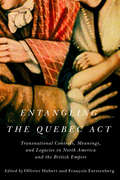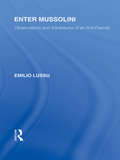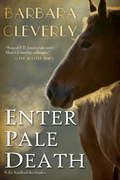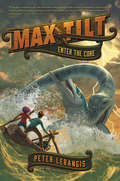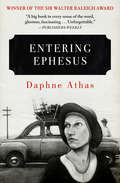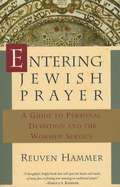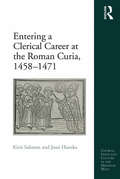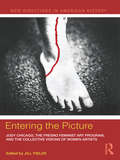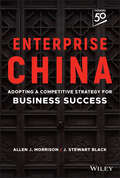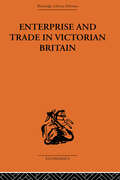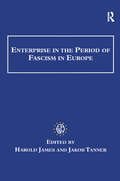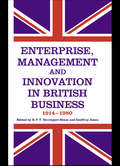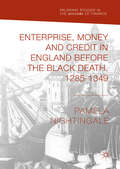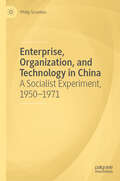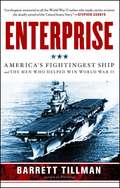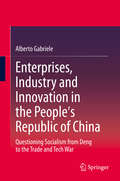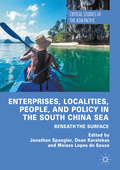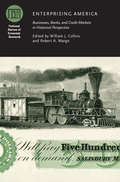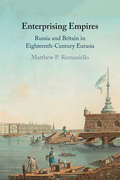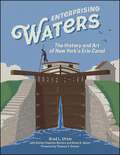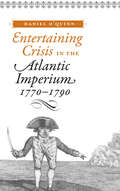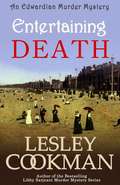- Table View
- List View
Entanglements: Conversations on the Human Traces of Science, Technology, and Sound (The\mit Press Ser.)
by Simone TosoniConversations with a founder of the influential Social Construction of Technology (SCOT) approach in science and technology studies offer an introduction to the field.Science and technology studies (STS) is a relatively young but influential field. Scholars from disciplines as diverse as urban studies, mobility studies, media studies, and body culture studies are engaging in a systematic dialogue with STS, seeking to enrich their own investigations. Within STS, the Social Construction of Technology (SCOT) theory has proved to be one of the most influential in its neighboring fields. Yet the literature has grown so large so quickly, it is difficult to get an overview of SCOT. In this book, conversations with Trevor Pinch, a founder of SCOT, offer an introduction and genealogy for the field.Pinch was there at the creation—as coauthor of the groundbreaking 1984 article that launched SCOT—and has remained active through subsequent developments. Engaging and conversational, Pinch charts SCOT's important milestones. The book describes how Pinch and Wiebe Bijker adapted the “empirical program of relativism,” developed by the Bath School to study the social construction of scientific facts, to apply to the social construction of artifacts. Entanglements addresses five issues in depth: relevant social groups, and SCOT's focus on groups of users; the intertwining of social representation and practices; the importance of tacit knowledge in SCOT's approach to the nonrepresentational; the controversy over nonhuman agency; and the political implications of SCOT.
Entangling Alliances: Foreign War Brides and American Soldiers in the Twentieth Century
by Susan ZeigerThroughout the twentieth century, American male soldiers returned home from wars with foreign-born wives in tow, often from allied but at times from enemy nations, resulting in a new, official category of immigrant: the “allied” war bride. These brides began to appear en masse after World War I, peaked after World War II, and persisted through the Korean and Vietnam Wars. GIs also met and married former “enemy” women under conditions of postwar occupation, although at times the US government banned such unions.In this comprehensive, complex history of war brides in 20th-century American history, Susan Zeiger uses relationships between American male soldiers and foreign women as a lens to view larger issues of sexuality, race, and gender in United States foreign relations. Entangling Alliances draws on a rich array of sources to trace how war and postwar anxieties about power and national identity have long been projected onto war brides, and how these anxieties translate into public policies, particularly immigration.
Entangling the Quebec Act: Transnational Contexts, Meanings, and Legacies in North America and the British Empire (McGill-Queen's Studies in Early Canada / Avant le Canada #2)
by Ollivier Hubert and François FurstenbergBeyond redrawing North American borders and establishing a permanent system of governance, the Quebec Act of 1774 fundamentally changed British notions of empire and authority. Although it is understood as a formative moment - indeed part of the "textbook narrative" - in several different national histories, the Quebec Act remains underexamined in all of them. The first sustained examination of the act in nearly thirty years, Entangling the Quebec Act brings together essays by historians from North America and Europe to explore this seminal event using a variety of historical approaches. Focusing on a singular occurrence that had major social, legal, revolutionary, and imperial repercussions, the book weaves together perspectives from spatially and conceptually distinct historical fields - legal and cultural, political and religious, and beyond. Collectively, the contributors resituate the Quebec Act in light of Atlantic, American, Canadian, Indigenous, and British Imperial historiographies. A transnational collaboration, Entangling the Quebec Act shows how the interconnectedness of national histories is visible at a single crossing point, illustrating the importance of intertwining methodologies to bring these connections into focus.
Enter Mussolini: Observations and Adventures of an Anti-Fascist (Routledge Library Editions: Responding to Fascism)
by Emilio LussuEmilio Lussu was an Italian MP and Professor of Political Economy, who was imprisoned because of his opposition to Mussolini. In 1929 he escaped with two fellow prisoners from the island of Lipari. Enter Mussolini combines an account of Mussolini’s rise to power and a critique of the Italian fascist movement that was influential at a time when many observers were still sympathetic to fascism, at least in its Italian guise. It was first published in English in 1936.
Enter Pale Death
by Barbara CleverlyOne morning before dawn in the stables of her country estate, Lady Truelove meets a violent death in an encounter with a dangerous horse. Classified as "death by misadventure," this appears a gruesome accident. But Scotland Yard Detective Joe Sandilands suspects foul play--a misgiving he is struggling to separate from his personal grievances toward Sir James Truelove, who is Lady Truelove's widower and the influential academic patron of Dorcas Joliffe, whom Joe one day hopes to marry.Joe enlists old friend and former constable Lily Wentworth to trail James, and finds an ally in a fellow police officer familiar with the Truelove estate. But as the investigation yields surprising secrets about one of England's most powerful families, Joe discovers how little he knows about not only the gilded lives of the moneyed, but also his relationship with Dorcas. Is Joe prepared to risk a future with the girl he loves to uncover the truth behind Lady Truelove's death?From the Hardcover edition.
Enter the Core (Max Tilt #3)
by Peter LerangisMax Tilt thinks his luck is finally changing, thanks to his great-great-great-grandfather Jules Verne’s unfinished, unpublished manuscript, The Lost Treasures. Using the clues Verne left behind, Max and his cousin Alex were able to bottle the magical healing elements needed to cure his mother’s illness just in the nick of time. <p><p> But then Max and Alex discover that the vials were stolen by their former friend, Bitsy. She has plans to use them to save the world—but her plans might be much more deadly than they seem. And so now it’s up to Max and Alex to stop her before it’s too late. <p> Working against the odds, the two kids glean clues from one of Verne’s best-loved books, Journey to the Center of the Earth. In it, they discover a map to their most dangerous destination yet—the very core of the world. And so now the two cousins are off on their most unlikely, most important quest yet—literally to save the world! It’s the final installment of the riveting adventure series from master storyteller and New York Times bestselling author Peter Lerangis.
Entering Ephesus
by Daphne AthasWinner of the Sir Walter Raleigh Award: A humorous and unparalleled account of the lives of three young sisters during the Great Depression. It is 1939 and life has changed drastically for the Bishop family. After losing their money and being forced to abandon their lovely seaside home in Connecticut, they move to the all-black Southern town of Ephesus. Patriarch P. Q. (which might stand for Peculiar) is a dreamer whose failed attempts at various schemes have landed the Bishops in a squalid shack that never stays warm and collects soot like a dustbin. And Mrs. Bishop is having an impossible time adjusting to their less than aristocratic conditions. But adolescent daughters Irene, Urie, and the zany Loco Poco—with their eccentric personalities and clothes made from tablecloths—won&’t let anything stop them from taking on the world. Little Women meets The Grapes of Wrath, Daphne Athas&’s award-winning novel has been hailed by critics and named one of the best books of the year by Time magazine. Entering Ephesus is a glorious and unforgettable story of life during the Great Depression through the eyes of three young, vivacious women.
Entering Jewish Prayer: A Guide to Personal Devotion and the Worship Service
by Reuven HammerThis engaging and informative book provides an introduction to the liturgy of the Siddur--the Jewish prayerbook. More than a "how-to" guide, this resource deals with basic issues for the modern worshiper, the historical compilation of the Siddur, and much more.
Entering a Clerical Career at the Roman Curia, 1458-1471 (Church, Faith and Culture in the Medieval West)
by Kirsi Salonen Jussi HanskaBuilding on recent revisionist histories of the quality and ability of the late medieval clergy, this is a comprehensive survey of the ordinations of priests at the Roman curia during the pontificates of Pius II (1458-1464) and Paul II (1464-1471). This period has often been presented as one of stasis within the Catholic Church, falling between the conciliar movement of the first half of the fifteenth century and the Protestant Reformation and counter-reformation of the sixteenth century. However the authors argue that this period was one of gradual reform, whereby the Church attempted to define and control the quality of the clergy. The study analyses archival documentation to reconstruct exactly how young men entered a clerical career, and also what influence practices at the curia had on wider clerical ordinations. The book concentrates especially on the role of the Apostolic Penitentiary in controlling the quality of priest candidates and on the role of Camera Apostolica in carrying out ecclesiastical ordinations in the papal curia. In considering the rules of who could enter the clerical career, and also why and how these rules might be circumvented, this book sheds new light on the late medieval clergy.
Entering the Picture: Judy Chicago, The Fresno Feminist Art Program, and the Collective Visions of Women Artists (New Directions in American History)
by Jill FieldsIn 1970, Judy Chicago and fifteen students founded the groundbreaking Feminist Art Program (FAP) at Fresno State. Drawing upon the consciousness-raising techniques of the women's liberation movement, they created shocking new art forms depicting female experiences. Collaborative work and performance art – including the famous "Cunt Cheerleaders" – were program hallmarks. Moving to Los Angeles, the FAP produced the first major feminist art installation, Womanhouse (1972). Augmented by thirty-seven illustrations and color plates, this interdisciplinary collection of essays by artists and scholars, many of whom were eye witnesses to landmark events, relates how feminists produced vibrant bodies of art in Fresno and other locales where similar collaborations flourished. Articles on topics such as African American artists in New York and Los Angeles, San Francisco’s Las Mujeres Muralistas and Asian American Women Artists Association, and exhibitions in Taiwan and Italy showcase the artistic trajectories that destabilized traditional theories and practices and reshaped the art world. An engaging editor’s introduction explains how feminist art emerged within the powerful women’s movement that transformed America. Entering the Picture is an exciting collection about the provocative contributions of feminists to American art.
Enterprise China: Adopting a Competitive Strategy for Business Success
by J. Stewart Black Allen J. MorrisonHow to adapt your firm&’s competitive strategy to the modern reality of Chinese enterprise Enterprise China: Adopting a Competitive Strategy for Business Success delivers a roadmap for business executives competing in and with China. Prepared by a team of renowned management researchers and strategists, the book examines the often-misunderstood interconnectedness of the Chinese state and Chinese businesses, demonstrating that individual firms and companies are often just the tip of the iceberg. The authors explain how the overarching vision, ambition, and strategy of the State impact and guide key commercial enterprises and how this affects Western business interests. In the book, you&’ll also find: Explorations of the competitive strategy and associated tactics of Chinese enterprise Strategies and tactical options for Western business executives as they compete in and with the Chinese state Descriptions of the key factors business executives must assess as they do business in and with ChinaAn essential discussion of one of the great economic powerhouses of contemporary history, Enterprise China belongs in the libraries of business executives, policy makers, and thought leaders seeking perspective on an unavoidable and determined competitor.
Enterprise Denied: Origins of the Decline of American Railroads, 1897-1917
by Albro MartinA 1971 piece that explores the struggle of the American Railroads in the early twentieth century.
Enterprise and Trade in Victorian Britain: Essays in Historical Economics
by D. N. McCloskeyThe essays in this book focus on the controversies concerning Britain's economic performance between the mid-nineteenth century and the First World War. The overriding theme is that Britain's own resources were consistently more productive, more resilient and more successful than is normally assumed. And if the economy's achievement was considerable, the influence on it of external factors (trade, international competition, policy) were much less significant than is normally supposed. The book is structured as follows: Part One: The Method of Historical Economics Part Two: Enterprise in Late Victorian Britain Part Three: Britain in the World Economy, 1846-1913.
Enterprise in the Period of Fascism in Europe (Studies in Banking and Financial History)
by Harold James Jakob TannerThe essays in this volume consider the involvement of business corporations and of individual businessmen in the politics of the 1930s and 1940s: in the move away from the market and also from democracy, towards state control and authoritarianism, including the massive intervention of the state in property rights. How far did businesses attempt to guide this intervention for their own purposes, and to what extent did they succeed? This debate deals, centrally, with the role of German business, of banks, of industrial corporations, and of small tradesmen in the Nazi regime. An older discussion of how they may have facilitated the Nazi takeover has been supplemented here by an investigation into how they made the regime’s policies possible, and the extent to which the profit motive drove them to participate - with sometimes more, sometimes less enthusiasm - in the politics of inhumanity. Such discussion has been given further impetus by legal action, initially in the United States, in the form of class action suits on behalf of the victims of Nazism. What do such legal and political debates mean for business history? What are the current responsibilities of business facing the consequences of historical action? And what lessons should be learned concerning the ethics of business behaviour? The contributions to this volume were originally presented as papers at a conference organised by the Society for European Business History in Paris in November 1998.
Enterprise, Management and Innovation in British Business, 1914-80
by Geoffrey Jones R.P.T. Davenport-HinesThis title available in eBook format. Click here for more information.Visit our eBookstore at: www.ebookstore.tandf.co.uk.
Enterprise, Money and Credit in England before the Black Death 1285–1349 (Palgrave Studies in the History of Finance)
by Pamela NightingaleThis book charts the contributions made to the development of the late medieval English economy by enterprise, money, and credit in a period which saw its major export trade in wool, which earned most of its money-supply, suffer from prolonged periods of warfare, high taxation, adverse weather, and mortality of sheep. Consequently, the economy suffered from severe shortages of coin, as well as from internal political conflicts, before the plague of 1348-9 halved the population. The book examines from the Statute Merchant certificates of debt, the extent to which credit, which normally reflects economic activity, was affected by these events, and the extent to which London, and the leading counties were affected differently by them. The analysis covers the entire kingdom, decade by decade, and thereby contributes to the controversy whether over-population or shortage of coin most inhibited its development.
Enterprise, Organization, and Technology in China: A Socialist Experiment, 1950-1971
by Philip ScrantonGiven the near-silence in technological and business history about post-World War II socialist enterprises, this book gives voice to a generation of Communist China’s managers, entrepreneurs, cadres, and workers from the Liberation to the early 1970s. Using recently-opened online archival resources, it details and assesses the course of technical and organizational experimentation at state-owned, cooperative, and private enterprises as the PRC strove to construct a socialist economy through trial-and-error initiatives. Core questions treated are: How did Chinese enterprises operate, evolve, experiment, improvise and adjust during the PRC’s first generation? What technological initiatives were crucial to these processes, necessarily developed with limited expertise and thin financial resources? How could constructing “socialism with Chinese characteristics” have helped lay foundations for the post-1980 “Chinese miracle,” as the PRC confidently entered the 21st century while Soviet and Central European socialisms crumbled? And what might current-day Western managers and entrepreneurs learn from Chinese practice and performance a half-century ago? Readers can anticipate a granular, bottom-up analysis of how businesses worked day-to-day in a planned economy, how enterprise practices and technological strategies shifted during the first postwar generation, how managers and technicians emerged after the capitalist exodus, how organizations experimented and adapted, and how the controversies and convulsions of the PRC’s early decades fashioned durable technical and organizational capabilities.
Enterprise: America's Fightingest Ship and the Men Who Helped Win World War II
by Barrett TillmanThis is the epic and heroic story of the aircraft carrier USS Enterprise and of the courageous men who fought and died on her from Pearl Harbor to the end of the conflict. Acclaimed military historian Barrett Tillman recounts the World War II exploits of America’s most decorated warship and its colorful crews— tales of unmatched daring and heroism.
Enterprises, Industry and Innovation in the People's Republic of China: Questioning Socialism from Deng to the Trade and Tech War
by Alberto GabrieleThis book analyses and critically evaluates the development of two key components of China’s economy: the network of productive enterprises, and the national innovation system, from the inception of market-oriented reforms to the present day. The approach is a partly novel one, albeit inspired to classical political economy, rooted in the structure and evolution of social relations of production and exchange and of the institutional setting in these two crucial domains. The main findings are twofold: First, the role of planning and public ownership, far from withering, has being upheld and qualitatively enhanced, especially throughout the most recent stages of industrial reforms. Second, enterprises are increasingly participating - along with universities and research centers - in a concerted and historically unparalleled effort to dramatically upgrade China’s capacity to engage in indigenous innovation. As a result, China’s National Innovation System has been growing and strengthening at a pace much faster than that of the national economy as a whole. The book also presents a speculative and provisional perspective on the validity, and meaning, of the claim that the country’s socioeconomic system is indeed a form of socialism with Chinese characteristics. It will be on interest to students and scholars researching China, politics, and development economics.
Enterprises, Localities, People, and Policy in the South China Sea
by Jonathan Spangler Dean Karalekas Moises Lopes de SouzaThis volume takes readers beneath the surface of the South China Sea by exploring critical but under-researched issues related to the maritime territorial disputes. It draws attention to the importance of private sector, civil society, and subnational actors' roles in the disputes and sheds light on key policy issues that are addressed less often in the literature. By going beyond mainstream analyses focused solely on issues of traditional security, resource economics, and international law, it offers a fresh and engaging look at the South China Sea disputes. The book is divided into five parts - historical foundations, enterprises, localities, people, and policy - and its chapters investigate historiography in the region, the global defense industry's role as beneficiary of the disputes, tourism as a territorial strategy, the roles of provinces and local governments, disaster management, confidence-building measures, environmental and science diplomacy, and other topics seldom discussed in other analyses of the South China Sea disputes. The book's diverse content and fresh perspectives make it an essential read not only for policymakers and those in the international relations community but also for all others interested in gaining a more well-rounded understanding of the many issues at stake in the South China Sea maritime territorial disputes.
Enterprising America
by Robert A. Margo William J. CollinsThe rise of America from a colonial outpost to one of the world's most sophisticated and productive economies was facilitated by the establishment of a variety of economic enterprises pursued within the framework of laws and institutions that set the rules for their organization and operation. To better understand the historical processes central to American economic development, Enterprising America brings together contributors who address the economic behavior of American firms and financial institutions--and the associated legal institutions that shaped their behavior--throughout the nineteenth and early twentieth centuries. Collectively, the contributions provide an account of the ways in which businesses, banks, and credit markets promoted America's extraordinary economic growth. Among the topics that emerge are the rise of incorporation and its connection to factory production in manufacturing, the organization and operation of large cotton plantations in comparison with factories, the regulation and governance of banks, the transportation revolution's influence on bank stability and survival, and the emergence of long-distance credit in the context of an economy that was growing rapidly and becoming increasingly integrated across space.
Enterprising Empires: Russia and Britain in Eighteenth-Century Eurasia
by Matthew P. RomanielloCommercial competition between Britain and Russia became entangled during the eighteenth century in Iran, the Middle East, and China, and disputes emerged over control of the North Pacific. Focusing on the British Russia Company, Matthew P. Romaniello charts the ways in which the company navigated these commercial and diplomatic frontiers. He reveals how geopolitical developments affected trade far more than commercial regulations while also challenging depictions of this period as a straightforward era of Russian economic decline. By looking at merchants' and diplomats' correspondence and the actions and experiences of men working in Eurasia for Russia and Britain, he demonstrates the importance of restoring human experiences in global processes and provides individual perspective on this game of empire. This approach reveals that economic fears, more than commodities exchanged, motivated actions across the geopolitical landscape of Europe during the Seven Years' War and the American and French Revolutions.
Enterprising Waters: The History and Art of New York's Erie Canal (Excelsior Editions)
by Brad L. UtterOne of the largest public works projects in American history, the Erie Canal inspired a nationwide transportation revolution and directed the course of New York and American history. When completed in 1825, the engineering marvel unlocked the Western interior for trade and settlement, boomtowns sprang up along the canal's path, and New York City grew to be the nation's most powerful center of international trade. Millions of people poured into New York (and some through it) to take advantage of the tremendous opportunities provided by the canal, influencing settlement and the social, political, and commercial landscapes of America.Produced in honor of the bicentennial of the beginning of construction of the canal, Enterprising Waters—a companion catalog to the New York State Museum's exhibition of the same name—includes reproductions of objects and images from the collections of more than thirty-five different institutions and individual lenders. It also contains reproductions of fifty-nine works of art used in the companion exhibition "Art of the Erie Canal." Themes of politics, engineering, commerce, life on the canal, and more are paired with full color images of artifacts, documents, and images to bring this unique American story to life, from its inception to today.
Entertaining Crisis in the Atlantic Imperium, 1770–1790
by Daniel O'QuinnHonorable Mention, 2012 Joe A. Callaway Prize in Drama and TheaterFirst Place, Large Not-for-Profit Publisher, Typographic Cover, 2011 Washington Book Publishers Design and Effectiveness AwardsLess than twenty years after asserting global dominance in the Seven Years' War, Britain suffered a devastating defeat when it lost the American colonies. Daniel O'Quinn explores how the theaters and the newspapers worked in concert to mediate the events of the American war for British audiences and how these convergent media attempted to articulate a post-American future for British imperial society.Building on the methodological innovations of his 2005 publication Staging Governance: Theatrical Imperialism in London, 1770-1800, O’Quinn demonstrates how the reconstitution of British imperial subjectivities involved an almost nightly engagement with a rich entertainment culture that necessarily incorporated information circulated in the daily press. Each chapter investigates different moments in the American crisis through the analysis of scenes of social and theatrical performance and through careful readings of works by figures such as Richard Brinsley Sheridan, William Cowper, Hannah More, Arthur Murphy, Hannah Cowley, George Colman, and Georg Friedrich Handel. Through a close engagement with this diverse entertainment archive, O'Quinn traces the hollowing out of elite British masculinity during the 1770s and examines the resulting strategies for reconfiguring ideas of gender, sexuality, and sociability that would stabilize national and imperial relations in the 1780s. Together, O'Quinn's two books offer a dramatic account of the global shifts in British imperial culture that will be of interest to scholars in theater and performance studies, eighteenth-century studies, Romanticism, and trans-Atlantic studies.
Entertaining Death: The Alexandrians Series Book Two
by Lesley CookmanThe second instalment in the Alexandrians series of mysteries set in Edwardian-era Kent by popular crime novelist Lesley Cookman.
